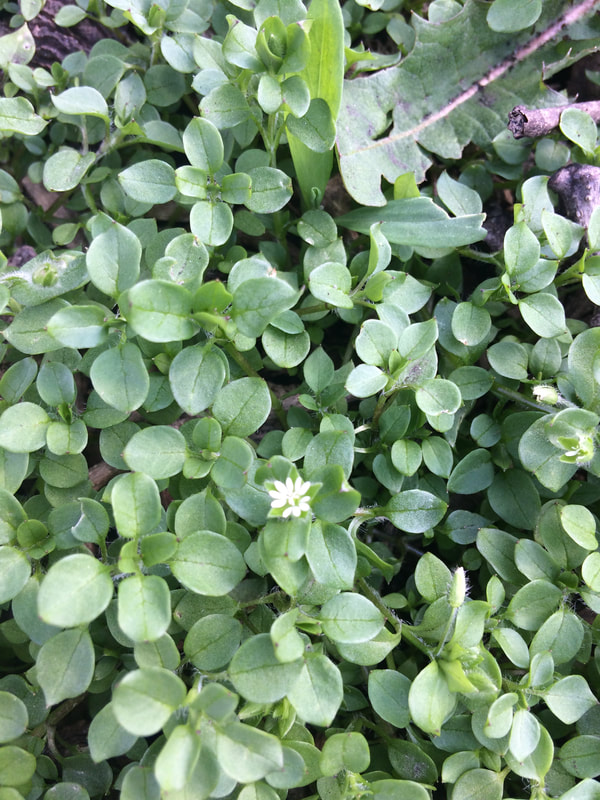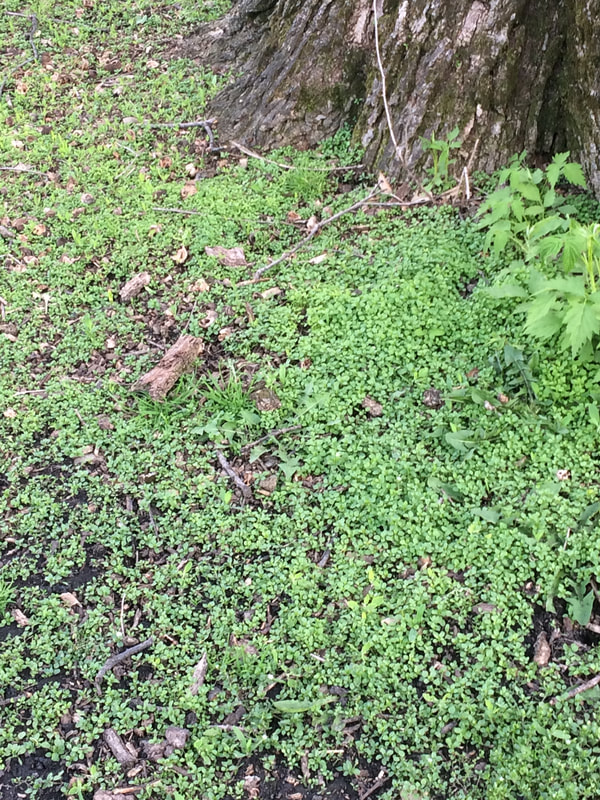|
The chickweed patch on my land did not do well* this year so the kids and I packed up a picnic and went on a search for some. I knew just the place. I harvested some chickweed there a few years ago while hunting for morels. When we arrived, the spot I had in mind was flooded. I searched a bit more and sure enough, I found a green and luscious patch nestled in between large exposed tree roots.
After harvesting a bit of chickweed, I really enjoyed just watching my kids play. I didn't bring a book and I was out of data on my phone so I wasn't distracted. Time just flies by so I am really trying to just enjoy the moment and their company! *EDIT: I wasn't patient enough, now my patch looks great! Chickweed Stellaria media Family: Caryophyllaceae Parts Used: aerial portions (leaves, stems, flowers) Harvesting Guidelines: Whenever I find a chickweed patch, the first thing that comes to mind is "ahh I just want to lay down in it!" Chickweed is an easy-to-grow perennial plant that loves nutrient-rich, moist soil in partial to full shade. It is one of the first greens to emerge in the spring. I am always eager to add it to my diet after the long winter months. "Use a scissors to harvest the young plant. It can be harvested while flowering, but avoid harvesting it if it has gone to seed as it becomes more tough and fibrous. Regularly harvesting chickweed will inspire it to branch and produce thick regrowth." (herbmentor.com) *Chickweed is best when eaten, tinctured, or prepared fresh. Safety: "As with any other herb, some people may have an allergy to chickweed but most do not. Contact dermatitis has been reported in some cases. Chickweed is generally regarded as safe in food doses for pregnant and lactating women. Large doses may cause digestive upset with diarrhea, especially if large quantities of seeds are eaten" (Bone 2005) *Wildcrafted Melissa's favorite things about Chickweed: -I love the way fresh chickweed tastes. My body craves it during the winter months and when it is in season, I nibble on it whenever possible. Chickweed is high in many nutrients including calcium, iron, phosphorous, magnesium, potassium, and vitamins A, C, E, B-complex. The high nutrient content makes it highly nourishing and increases your energy. It is a great plant to include in your diet while recovering from an illness to help you regain your strength. -I love making an infused oil with chickweed. Usually I use dried herbs to prepare an oil infusion but chickweed is best prepared fresh. I harvest the plant and let it wilt for about 24 hours. I blend it with a mixture of organic sunflower and grape seed oil and keep it warm in a double boiler for 4-8 hours. The end product is a beautiful color and smells just like the plant! I use the oil in many of my healing balms. It is the main herb in my anti-itch balm. It is emollient and very soothing to dry, irritated, or inflamed skin. It is especially effective for rashes, eczema, soothing minor cuts, burns, and wounds. This is because it is a very juicy and cooling herb. It is great at lubricating dry and irritated skin. Definitely an herb you want to have around when you need a little comforting and soothing! -Blair (2014) recommends chickweed for removing congestion and infection from the body and suggests chickweed breaks down “inferior proteins in the body (such as tumors).” Saponins found in chickweed help dissolve excesses in the body such as mucus, bacteria, undigested proteins, and fat cells, and help with assimilation and elimination of cysts and lumps (Blair, 2014). Chickweed is particularly helpful for dispersing lipomas (fatty tumors) (Wood, 2008). This is very interesting to me because I just took my son in to the doctor to get a small bump checked out. It happens to be a lipoma! Good thing I just harvested chickweed and made an oil with it! Crazy how things work out! Vocab: Saponins are a special type of glycoside. We use saponins daily in our soaps. Saponins break up fat molecules. Saponins are also adaptogenic, diuretic, anti-spasmodic, immune modulating, expectorant, and more. "When plants high in saponins are agitated in water, a visible soap-like foam appears. This foaming ability is caused by the interaction of fat soluble and water soluble constituents"(herbmentor.com) Some herbs with a high saponin content can be irritating if consumed on an empty stomach. How we use Chickweed -Chickweed was one of the first herbs my kids learned about. They were introduced to it through an awesome herbal program called: Herb Fairies. We enjoy going on walks and nibbling on it. The kids love the tiny flowers! -Adding to salads -Using the infused oil on irritated and hot skin conditions. Herbal Beauty Products -Anti Itch Salve -Muscle and Joint Salve -Anti Itch Roll-on Harvest Journal entries are a way to introduce you to the plants that grow in our eco-system and that we use in our products. I hope that you are encouraged to do your own research and get out and harvest your favorite plants.
1 Comment
|
Categories
All
Melissa Kruse
Archives
May 2024
|







 RSS Feed
RSS Feed